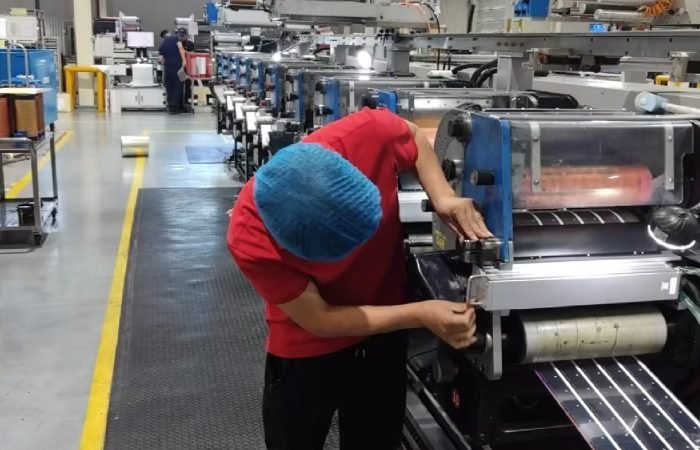Narrow web flexo printing relies on precise control. LED UV curing is a cornerstone of this process. When it falters, it disrupts your entire workflow. Understanding common LED curing problems is key to swift resolution. We’ll explore these challenges and offer expert solutions. This will help you maintain consistent, high-quality label production.
Why LED UV Curing in Flexo?
LED UV lamps offer significant advantages over traditional mercury lamps. They provide instant on/off capability. This saves energy and reduces heat load on sensitive substrates. They also boast a longer lifespan. The spectral output of LEDs is highly specific. This means better ink compatibility and curing efficiency. However, this specificity can also lead to troubleshooting scenarios if not managed correctly.
Common LED Curing Issues and Their Fixes
One prevalent issue is incomplete curing. This often manifests as sticky or easily scratched ink. It’s frustrating, especially on short runs. Several factors can contribute to this.
Ink Formulation Mismatch: LED UV inks are formulated for specific wavelengths. If you use an ink not designed for your LED lamps, curing will be poor. Always verify ink specifications with your supplier. Ensure the ink’s photoinitiator package is compatible with your LED’s emission spectrum. A mismatch here is a fundamental problem.
Insufficient Energy Output: Your LED lamps need to deliver enough energy. This is measured in Joules per square centimeter (J/cm²). If the lamps are aging, dirty, or the power supply is unstable, energy output drops. Regularly clean the lamp heads. Inspect them for any physical damage. Consult your manufacturer’s guidelines for recommended energy levels for your specific inks. Power supply diagnostics might be needed for persistent issues.
Improper Web Speed: Flexo printing operates at high speeds. The web must travel at a speed that allows adequate exposure time to the UV light. Too fast a web speed means the ink doesn’t receive sufficient UV energy. Conversely, too slow can lead to overheating. Calibrate your press speed carefully. Work with your ink and lamp suppliers to determine the optimal balance.
Incorrect Wavelengths: While LEDs offer specific wavelengths, variations can occur. If your lamps are emitting at wavelengths outside the ink’s absorption spectrum, curing will be inefficient. This is less common with modern, quality LED systems. However, it’s worth confirming your lamp specifications if all else fails. This often requires specialized measurement equipment.
Ink Dot Gain and Poor Ink Transfer: Sometimes, the issue isn’t directly with the UV light. It can be how the ink is applied. Poor ink transfer or excessive dot gain can lead to thin ink films. Thin ink films cure faster, but they also lack the ink mass to absorb enough UV energy. This can result in surface tackiness.
Solutions: Optimize anilox roll selection and ink viscosity. Ensure your doctor blade setup is correct. Proper ink transfer ensures an adequate ink film thickness for effective curing. This is a critical factor in achieving a robust, cured print.
Adhesion Problems: Beyond tackiness, you might experience poor adhesion to the substrate. This is another sign of incomplete curing or an incompatibility.
Substrate Surface Energy: The substrate’s surface energy plays a significant role. If the surface energy is too low, the ink won’t wet out properly. This hinders adhesion. Sometimes, surface treatments are necessary. Corona or flame treatments can increase surface energy. Test your substrate’s surface energy. Consult with your material supplier.
Chemical Incompatibility: Certain inks, coatings, or additives can interfere with UV curing. Additives in coatings might act as UV blockers. This prevents the UV light from reaching the ink. Ensure all layers in your print stack are compatible. Test coatings and inks together before a full production run.
Environmental Factors: Temperature and humidity can influence curing. High temperatures can sometimes accelerate curing reactions. However, extreme heat can degrade certain ink components. Maintain a stable pressroom environment. Monitor temperature and humidity levels. These factors are often overlooked but can impact performance.
Troubleshooting Checklist for Flexo LED Curing
When troubleshooting, a systematic approach is best.
- Verify Ink: Confirm the ink is specifically designed for LED UV curing and your lamp’s wavelength.
- Check Energy Output: Measure or confirm the expected UV energy output of your lamps.
- Inspect Lamps: Ensure lamps are clean and free from damage.
- Web Speed: Confirm the press speed is appropriate for the ink and UV system.
- Ink Film Thickness: Evaluate anilox roll, viscosity, and doctor blade for proper ink transfer.
- Substrate Check: Verify the substrate’s surface energy and compatibility with UV inks.
- Coating/Additive Review: Ensure all pressroom chemicals are compatible with UV curing.
- Environmental Control: Monitor and stabilize pressroom temperature and humidity.
Advanced Considerations
For narrow web printers, optimizing the entire curing path is essential. This includes the distance between the UV lamps and the substrate. It also involves the airflow around the curing station. Proper ventilation helps manage heat and can prevent premature curing of the ink film before it hits the lamp.
The Importance of Collaboration
Don’t hesitate to involve your suppliers. Your ink manufacturer, press supplier, and LED lamp provider are valuable resources. They can offer specific insights into their products. They can help diagnose issues unique to your setup. Collaborative problem-solving often yields the fastest and most effective solutions.
Preventative Maintenance is Key
Regular maintenance of your LED UV curing system is not just about fixing problems. It’s about preventing them. Schedule routine cleaning of the lamp heads and reflectors. Monitor energy output over time. Keep detailed records of ink batches, press settings, and any curing-related issues encountered. This historical data is invaluable for identifying trends and proactively addressing potential failures.
By understanding these common issues and implementing these expert solutions, you can ensure your flexo printing operation achieves consistent, high-quality results with LED UV curing. This leads to greater efficiency and fewer costly production interruptions. Focus on these details, and your labels will shine.












